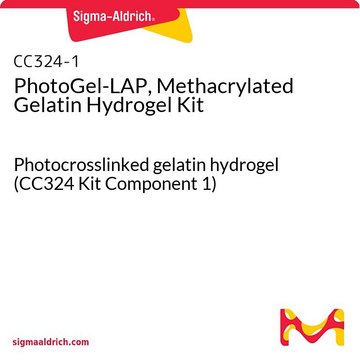927058
TissueFab® bioink kit
(Gel)ma Laminin -UV/365 nm, low endotoxin
Synonyme(s) :
0.2 um sterile filtered, 3D Bioprinting, GelMA, Gelatin methacrylamide, Gelatin methacrylate, Gelatin methacryloyl, Laminin
About This Item
Produits recommandés
Niveau de qualité
Forme
viscous liquid (gel)
Impuretés
<5 CFU/g Bioberden: Aerobic
<5 CFU/g Bioberden: Fungal
<50 EU/mL Endotoxin
Couleur
pale yellow to colorless
pH
6.5-7.5
Viscosité
3-30 cP
Température de stockage
−20°C
Vous recherchez des produits similaires ? Visite Guide de comparaison des produits
Description générale
Application
(Gel)ma Laminin -UV/365 nm, low endotoxin features a ready-to-use bioink that is formulated for high cell viability, and printability and is designed for extrusion-based 3D bioprinting and subsequent 365 nm light crosslinking and a solution of Laminin to enhance the bioink. The bioink kit can be used with most extrusion-based bioprinters, are biodegradable, and are compatible with human mesenchymal stem cells (hMSCs) and other diverse cell types. TissueFab®- Low endotoxin GelMA-UV Laminin kit enables the precise fabrication of 3D cell models and tissue constructs for research in 3D cell biology, tissue engineering, in vitro tissue models, and regenerative medicine. Suitable for final Laminin concentrations up to 200ug/ml.
Caractéristiques et avantages
Low Endotoxin, low bioburden: Endotoxins have been demonstrated negatively impact cellular growth, morphology, differentiation, inflammation and protein expression. Bioburden is defined as the number of contaminated organisms found in a given amount of material. We test each lot for endotoxins as well as total bioburden (aerobic and fungal) to minimize unwanted interactions. For more information: https://www.sigmaaldrich.com/US/en/technical-documents/technical-article/microbiological-testing/pyrogen-testing/what-is-endotoxin
Informations légales
Produit(s) apparenté(s)
Code de la classe de stockage
10 - Combustible liquids
Faites votre choix parmi les versions les plus récentes :
Certificats d'analyse (COA)
Désolés, nous n'avons pas de COA pour ce produit disponible en ligne pour le moment.
Si vous avez besoin d'assistance, veuillez contacter Service Clients
Déjà en possession de ce produit ?
Retrouvez la documentation relative aux produits que vous avez récemment achetés dans la Bibliothèque de documents.
Notre équipe de scientifiques dispose d'une expérience dans tous les secteurs de la recherche, notamment en sciences de la vie, science des matériaux, synthèse chimique, chromatographie, analyse et dans de nombreux autres domaines..
Contacter notre Service technique





